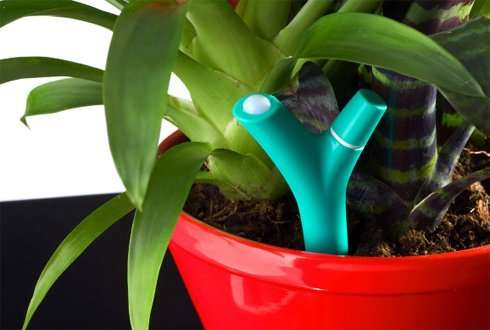Plant asks for care via Flower Power plant sensor

It looks like a stylish twig but is loaded with high technology: we're talking about the Flower Power, a plant sensor produced by French company Parrot which uses a handy app to tell people exactly when a plant needs care. This advanced product integrates the specialised knowledge about houseplants and pot plants of scientist Filip van Noort from Wageningen UR.
Water, light, temperature and nutrients
A smartphone app links the Flower Power to a database with information on 6,000 plants. The device is then placed next to the plant in the pot, and a sensor monitors the plant's wellbeing, as measured by the moisture level, the degree of sunlight, the air temperature and the amount of nutrients in the pot. The app signals when it's time to water the plan or too dark.
Parrot hands-free sets and drones
Parrot is a French company which designs, develops and markets products for tablets and smartphones, including hands-free systems in cars, headphones, and drones for applications such as making maps. The Flower Power sensor is a relatively new product. Parrot came to Wageningen UR to share our knowledge about houseplants and pot plants.
Knowing your begonias from your Venus flytraps
"There's no reason why this shouldn't be possible," thought crop scientist Filip van Noort when Parrot asked him to define limit values for the plants. He started by selecting 370 pot plants, which together formed a reliable cross-section of the total number of plants in the database. Van Noort spent two months subjecting the plants to various tests.
"I first classified them into five categories, depending on the amount of light, nutrients and water, and the temperature, they needed globally. This put the begonia, which requires plenty of nutrients, in a different category than the Venus flytrap, which requires little."
Plants asking for care
Van Noort exposed the plants in each category to three light levels, ranging from little to lots of sunlight. By subsequently varying the temperature and the amount of water and nutrients, he found out how the plants perform in various conditions. "I looked at which conditions are optimal for a plant and what its minimum and maximum requirements for light, temperature, water and nutrition are."
Parrot subsequently integrated Van Noort's research into its database. As a result, users of Flower Power get an alert whenever one of their plants approaches one of these limit values. "It's like the plants were asking for care themselves. I'm glad that my research could contribute to something like this. And it clearly shows that our knowledge can be relevant everywhere, including in the living room."
Provided by Wageningen University

















